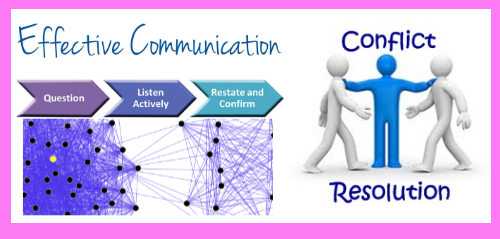
For this article, I will insert – Classroom moves – in the WHAT section so that I don’t lose track of them before the NOW WHAT section.


4 – Communication skills and conflict resolution
- Average version
- Avoids conflict
- Jumps to conclusions
- May fail to effectively communicate thoughts
- Communicates the same way for everyone
- Star version
- Makes thinking known and heard
- Identifies and acknowledges assumptions
- Resolves conflicts
- Varies communication style to suit teams and individuals
- Star actions
- Teach communication skills – listening skills, inquiry over advocacy, summarizing what was said
- Appreciate differences and communicate differently to match these
- Assign devil’s advocate to enliven discussions and avoid “group thinks
- Related classroom moves
- Teach and model good communication skills – listening skills, inquiry over advocacy, summarizing what was said
- Let students take tests to identify their communication styles
- Use communication tools to learn how to communicate with students who have varied communication styles
- Teach students how to use tools that describe how people with the same or different communication styles can effectively communicate with teach other (model strategies and give practice opportunities)
- Scaffold team conversations that allow all team members to communicate their thoughts and assumptions prior to making team decisions
- Teach students how to have a conflict resolving conversations (model it and offer fake practice opportunities). See here and here for ideas.
- Teach students how to play devil’s advocate role. Assign devil’s advocate role in specific class discussions.
5 – Systems thinking
- Average version
- Focuses on his department with tying connections to other departments
- Believes his team has little impact on other teams
- Star version
- Looks at big picture
- Thinks of impact team has on others
- Has a broad view of who are stakeholders (vendors, clients, family, etc)
- Is aware of unintended impact and consequences
- Star moves
- Have team member assume perspectives of various stakeholders and examine issues from these perspectives
- Encourage team to consider all possible consequences before making decisions
- Counteract limited thinking such as – us vs. them, I am my position, etc
- Related classroom moves
- Have students reflect on how their decisions affect others
- Connect projects to invested stakeholders that students need to consider while developing projects
- Have students assume perspectives of different stake holders and examine their work from these perspectives
- Guide students through brainstorming activities that help them realize all possible consequences for their choices prior to committing to selections
- Teach students about limiting thinking or bad self talk patterns and to identify when those limiting patterns have affected them in the past
- Teach students how to respond with their limiting self talk with more constructive, positive self talk
6 – Personal leadership
- Average version
- Stays in own comfort zone
- Only takes “safe bet” risks
- Star version
- Takes risks consistent with values
- Stretches others to move beyond doubts and fears
- Star moves
- Cultivate a developed point of view of your leadership style
- Know your leadership goals and vision
- Vary your leadership style to connect and challenge with your team members
- Share current areas of focus
- Ask for support and feedback from team
- Wear many hats at the right times – initiator, coach, model, facilitator, negotiator
- Respond to team’s emotions with balancing actions – attention, humor, empathy
- Related classroom moves
- Be aware of the mood of your students as individuals and as teams
- Use your awareness to select the appropriate message / style of communication
- Be aware of your long term academic & cultural goals for your classes and how your strategies are working toward these (or not)
- Share goals with students and ask for feedback from them
- Ask students for frequent feedback on learning activities
- Switch hats to suit the needs of your student (assessor, facilitator, coach, initiator, negotiator, director, follower, observer, etc.)
- Teach students how to be aware of the moods of their teammates and teach them appropriate responses for stressful situations such as: team member is angry, overwhelmed, behind on work, confused, apathetic, etc.
- Teach your students how to understand what communication strategies they find most motivating and how to communicate those to teachers and other students

Collaboration is one of the most important NT learning outcomes. Without strong collaboration skills, students can not effectively and positively complete projects with the aid of their team mates. Most students do not naturally have these skills when they arrive at PBL schools because individual work is highly prioritized in most non-PBL learning environments. Most PBL teachers did not attend PBL schools growing up, so they need training on what are / how to scaffold effective collaboration skills.

Preparation Steps
- Research what are effective collaboration skills. See Collaboration articles for ideas.
- Design tools, practices, and scaffolds that promote effective collaboration skills. See above and Collaboration articles for ideas.
Early Implementation Steps
- Implement tools, practices and scaffolds that develop teacher’s and students’ collaboration skills.
- Use informal assessments (observations supported by checklists) and student reflections to identify and fine tune effective strategies
Advanced Implementation Steps
- Have students reflect and identify the collaboration strategies that are working best for themselves and why.
- Incorporate effective strategies into classroom routines that promote strong collaboration in all student teams

- Collaboration articles
